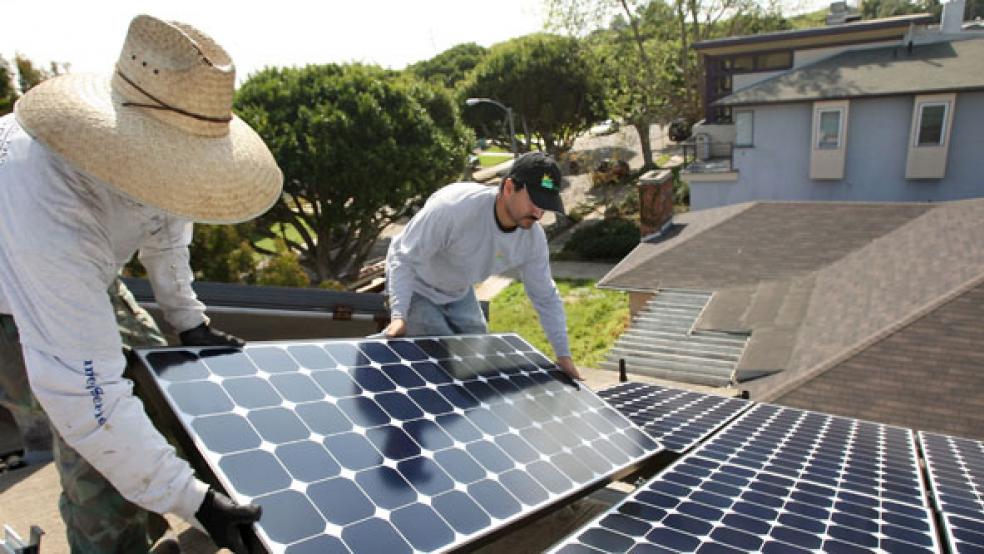Anyone can decide at any time to install a solar power system or energy efficient windows and appliances -- or otherwise improve the energy efficiency of their homes or businesses.
But the evidence is undeniable: Far more people go green if they get a tax break in return.
Back in 2006, when Congress passed a $2,000 credit for builders to construct homes that use 50% less energy than the prevailing standard, builders responded despite initial concerns that no one would be able to meet such strict standards. Three years later, fully one tenth of all new homes met the much tougher standard required for the credit.
Then in 2009 and 2010, when homeowners were able to claim a $1,500 credit for buying and installing energy-efficient doors, windows and appliances, they rushed to take advantage of it. “We estimate that the sales impact on our overall business was 10% to 15%,” says Jay Lund, president and CEO of window and door maker Andersen Corporation.
Clearly federal energy tax incentives play a big role in jump-starting a green energy movement. Yet now there is a good chance they will be scaled back significantly or eliminated altogether.
Already, the residential tax credit was cut back by Congress from $1,500 to $500 for this year, triggering a 16% decline in sales of windows and doors industry wide in the first six months of the year, according to the Windows and Doors Manufacturers Association.
That credit -- along with the builders’ $2,000 credit and various tax incentives for businesses -- is set to expire at the end of this year unless extended by Congress.
But even if they are extended, energy incentives are still at risk, particularly if the Republicans win control of the White House in the next year’s election, says Clint Stretch, director of legislative affairs at Deloitte & Touche.
“The classical conservative position is that credits and incentives for renewable energy or energy efficiency are not good policy,” Stretch says.
The mood has already been set by many of the Republican presidential candidates: Texas Governor Rick Perry’s tax plan includes a repeal of energy incentives. Former Godfather’s Pizza CEO Herman Cain wants to decrease or eliminate tax credits for renewable energy. Rep. Michele Bachmann of Minnesota has voted against tax incentives for renewable energy.
Even if President Obama – a strong advocate of green energy initiatives -- is reelected, “there is still going to be a push to take incentives out of the tax code in the context of tax reform,” according to Stretch .
Critics of energy tax incentives have a few legitimate bones to pick with the way they are currently designed. For example, it’s not that easy to measure the effectiveness of some of the measure.
Take one of the more generous federal programs: A 30% credit for solar energy installations for private homes and businesses. Since enacted in 2006, the solar energy industry has more than doubled in size and installations have shot up a staggering 800%, according to the Solar Energy Industry Association.
Some of that growth is almost certainly due to the tax incentive. Yet in light of other trends -- such as increased public awareness about solar energy and the declining cost of solar panels and related equipment – it’s difficult to accurately assess the full impact of tax incentives .
What’s more, because of the way some tax incentives are structured, they are available for some taxpayers, but not others. The residential energy credit, for example, is non refundable, meaning it must be used against an individual’s or family’s income tax liability. For lower-income taxpayers who end up having no tax obligation, the credit can’t be used.
Likewise, anyone subject to the Alternative Minimum Tax, which disallows most deductions and credits, may not get the full benefit of the credit.
Rob Williams, associate professor of agriculture and resource economics at the University of Maryland, says the tax breaks are so narrowly targeted that there are strict limits to their overall impact and benefit Once a deduction or credit is used to purchase solar-energy equipment, there are no other legal applications, and the incentive simply dries up, Williams says.
He prefers taking the opposite tack by forcing consumers to make energy-efficient improvements with the threat of a penalty. One way would be to impose a tax on “dirty energy,” such as a British thermal unit (BTU) tax or a carbon or gas tax. “This would give incentive to save energy in any way possible, rather than in one particular way supported by a tax incentive,” he says.
Interesting thought, but congressional Republicans are generally opposed to any tax increase, and the idea of a BTU tax died in Congress during the Clinton administraton.
Attempts in Congress to address problems with the incentive programs have been scattershot. Last year, some lawmakers recognized that many businesses weren’t able to take advantage of the 30% credit for solar energy installations, because they had no profits to show in this tough economic climate. Businesses must claim the tax credit against profits.
So Congress passed an option for businesses to get a grant instead of the credit. This was an important fix, but it will be short-lived and will expire at the end of this year.
It would be fair to say that the federal energy tax incentive programs have played a vital role in moving the nation toward making greater use of renewable energy. Advocates say this is an essential trend if U.S. officials and politicians are serious about trying to make the country a tad more energy efficient.
But there is certainly a lot of room for improvement: Nearly 84% of energy consumption still comes from fossil fuels in the U.S., 8.6% comes from nuclear electric power and 8.2% from renewable energy, such as wind, solar and geothermal power.
It is encouraging to note that while overall energy consumption has been on the rise for years (with the exception of 2009 at the depths of the Great Recession), the amount of energy used to produce each dollar of gross domestic products is in decline, according to the U.S. Energy Information Administration.
That decline is due to a number of factors, including stricter energy efficiency standards and the rise of service-based industries as a share of GDP. But tax incentives for alternative energy sources are among those factors, and to scale back or eliminate them would be shortsighted at this early stage of transitioning to green energy.
With the future of these energy tax credits very much up in the air, anyone thinking of taking advantage of them better get moving. And don’t just look for federal incentives. Many state governments, municipalities and utilities are offereing some generous breaks.
Check out www.dsireusa.org, a government-funded site run by the North Carolina Solar Center, to to get a full picture of the various federal, state, local and utility incentives that are still available.





